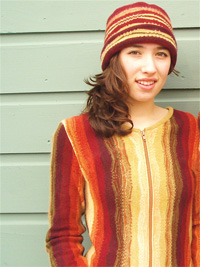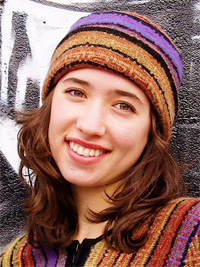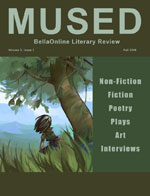An Interview with Karen Allen
 The beautiful rolling hills of the Berkshires are a textured canopy of leaf and stream, of winding roads and hand crafted wonders. Nestled into this bucolic region is the fiber art workshop of Karen Allen. Karen works alone in her studio, guiding her machines to create unique and luxurious cashmere sweaters, hats, scarves and other items.
The beautiful rolling hills of the Berkshires are a textured canopy of leaf and stream, of winding roads and hand crafted wonders. Nestled into this bucolic region is the fiber art workshop of Karen Allen. Karen works alone in her studio, guiding her machines to create unique and luxurious cashmere sweaters, hats, scarves and other items.Her shop opened in 2004, the natural progression from a life-long knitting hobby. "I started knitting when I was maybe four or five years old," explains Karen, "but not on the machines like I'm doing now. That's a fairly new thing. That was about 2002 - I went back to FIT [the Fashion Institute of Technology in NYC] and studied that." Karen had initially gone to FIT as a college student, and the textile arts drew her back in again.
Karen did not put down her yarn in the intervening years. Raiders of the Lost Ark, Starman and other movies were created accompanied by the sounds of her clicking needles.
Karen says, "You know, movie sets are notoriously boring. You're usually there as an actor 12 hours a day and maybe you're actually needed - even if you have a leading role in a film - maybe 3 or 4 hours of that day. That leaves you with 9 or 10 hours of just kind of sitting around waiting for the set to be ready, and waiting for the lighting to be ready. You desperately need something to do."
Karen has experimented with many yarns, and her shop reveals the fruits of those tests: "I only work with cashmere at this point. It was really a practical decision. In a way and it was based on the machines that I'm working on. There's a lot of fibers that are just not forgiving enough. You have a lot of difficulties on the machines with certain fibers. When I started working with cashmere on the machines most of those problems just disappeared."
Cashmere, also known as pashmina, is a high end yarn created from the cashmere goat. "It's a very kind of a heavy and yet flexible fiber, and it's a beautiful fiber. It's a wonderful fiber to work with."
Karen did her research before embarking into retail: "Generally in the cashmere marketplace they're always done in one color and they're pretty boring. It's a beautiful fiber but you don't see a lot of exciting, different types of things. I thought this could be my little niche, to work in a very colorful way where there's not a lot of other people doing it."
 Karen's artistic world revolves around the colors that speak to her soul, that bring out memories. For example, she notes a specific source for the Monterey design pattern. "The inspiration for the "Monterey" was really my dad. He had some blankets that he'd gotten down in Mexico so I really sort of named them after that, because they reminded me of the colors that went through these blankets. They were sort of a homage to these colors that I remember in these old Mexican blankets."
Karen's artistic world revolves around the colors that speak to her soul, that bring out memories. For example, she notes a specific source for the Monterey design pattern. "The inspiration for the "Monterey" was really my dad. He had some blankets that he'd gotten down in Mexico so I really sort of named them after that, because they reminded me of the colors that went through these blankets. They were sort of a homage to these colors that I remember in these old Mexican blankets."Other times she says the design grows naturally out of her love of certain color combinations. "Sometimes I will just play and throw colors together and I'll just start doing little experiments and I'll think, 'Oh! That looks interesting,' and it just kind of happens in a very non-thinking way. It's much more instinctive.
"I try to create a palette in a sense like a painter would. I tend towards colors that I love to be around, colors that I always have knit with, colors that I wear, colors that I put around me in my environment." In a very real way, Karen is painting with fiber, just as an impressionist would create landscapes with dots of oil.
Karen's tastes run towards the rich, dense end of the spectrum. She says, "I tend towards the deeper colors. I'm a little what I would call 'pastel phobic', I'm not drawn to pastels I don't really want to look at them or I don't want them around me. I would much rather be with the deeper tones, the heathers. I'll always love a rose as opposed to a pink. They just don't grab me."
Karen's biggest inspiration on her knitting and textile projects is Kaffe Fassett, a well known English knitter. Karen draws her ideas from the beauty around her. "I spent my life studying textiles from all over the world and my work is very color driven. There are colors that repeat themselves again and again in my work."
 Part of the challenge for her is working with the machines, convincing them to move past their binary computer limitations. "I'm dealing with my knowledge of the computers in these machines and how to trick them and how to get them to do certain things that they weren't really intended to do. I work with them in a way in which I break the rules of these patterns and I manipulate the machines in a way so I get effects that were never intended. That's a lot of where a lot of my creativity lies."
Part of the challenge for her is working with the machines, convincing them to move past their binary computer limitations. "I'm dealing with my knowledge of the computers in these machines and how to trick them and how to get them to do certain things that they weren't really intended to do. I work with them in a way in which I break the rules of these patterns and I manipulate the machines in a way so I get effects that were never intended. That's a lot of where a lot of my creativity lies."Karen does have a website for her shop, to display the types of items she sells, but the site is not intended to be a live order system. Customers need to call the shop to find out what is actually in stock, since every item is hand created by Karen herself. She faces the growing-pain challenges that many crafters struggle with once demand begins to exceed production capability.
"Unfortunately these days I find less and less time to be actually designing and I find more and more that just I'm knitting production. I get this list of things that people want me to knit and I then find an awful lot of my time is spent making things that people want that are versions of what I've already done." She adds, wistfully, "Maybe something will open up sometime soon where I can actually start reinventing things."
Being a true renaissance woman, Karen is not only a fantastic designer of luscious clothing, but also is a highly skilled Ashtanga yoga practitioner. "I've been practicing yoga since I was about seventeen," she says. "In the early nineties I became very focused on yoga practice. When I moved back to Massachusetts I actually opened a yoga school here, which is in the building that my studio is in right now. There's a yoga school right above me." She has since turned over control of that school to another group so that she could focus on her knitting projects.
For the yoga enthusiasts out there, Karen has a few favorite poses: "Janu Sirasana [sitting, bringing your head to your knee] is one of my favorites just because it felt so great in terms of both stretching my hamstrings and lower back - who doesn't need that! Tadasana [mountain pose] is a fantastic pose just because it's really the most simple and yet the most difficult pose.
"Shavasana [corpse pose] is also a favorite pose because it's really the reward of your practice, the shavasana where you just lay down in a pose at the end of your practice. If you've done a good practice and if you've been really focused - and you've breathed really deeply and clearly and if you've really opened up your system - you can actually have a profound experience of your interior self. You can actually have a unique thought! Which is hard to come by these days, we're so in constant response to things around us, we're so over stimulated by our environment. It's so rare to have a thought that isn't stimulated by something we're taking in through our eyes or our ears."
Karen even found a way to combine the benefits of yoga with the productive rhythm of knitting. She notes, "Often when I work on these machines - which are very challenging machines physically - I often do yoga breathing to try to not stress out my body while I am working. I'll get into kind of a way of breathing rhythmically with the machine because they're very hard on your physical body."
Having lived through both the fast paced life of Hollywood as well as the slower paced life in the quiet mountains of the Berkshires, Karen has found that a healthy path for her involves choosing her projects with wisdom and awareness. "I think that there is this tendency in our culture to think that more is better - and more is not necessarily better. Making more of anything is not necessarily better than making less. I've found this again and again in my life. When I started the yoga studio it grew so quickly that by two years into it I was completely and totally overwhelmed. You burn out. I'd rather do it on a smaller scale."
Karen advises, "I think you have to keep going back to the question, 'Am I having fun? Am I enjoying this or am I just another hamster on a wheel trying to make more, make more'. When I had the two women working for me a lot of times they got to do the things that I really wanted to do which is work on the machines and make the things."
While her employees enjoyed the fun of creation, Karen became swamped with the day to day activities of running the shop, managing the orders. "I found once I was in it that it wasn't really what I enjoyed, that I really like being here, putting on music and making a scarf or making a sweater," she recalls.
Over the years many well meaning people have tried to push Karen to grow her business, to launch her line in high end department stores, to expand to a larger scale. She is quite content creating her own product, and managing the business to sustain at that level.
For those crafters who are seeking to reach the self sustaining level, Karen has a plethora of helpful advice: "I think there's a couple of things that are important. Look at the market, really look at what the stores around you are and what it is you could make. I have a lot of people come into my store who want me to carry their things and a lot of them are just not sellable. I know that the people are working hard on them, but maybe they're making hats, and when you put the hat on it's one of those hats that would want to just pull the skin off your forehead.
"You have to be very discriminating and very self critical of what it you're doing so that you create something that is sellable, that people will want. And also maybe something unusual. People come into the store who are doing things that I feel like I see all over the place - they're knitting certain kinds of scarves and hats that I've already seen five different times in other stores or other people have come in and shown me very similar things. You have to try to figure out how to do something unique, something where you are finding a little void in the marketplace."
Karen advises crafters to talk with the store owners, to learn what will sell well. "There were suggestions that people at these stores made - one of them being that it was the cashmere stuff that people were going to want and the other being somebody said 'your scarves need to be bigger - they need to be wider and longer' and I took a lot of this stuff to heart. It changed the way in which I started to do things.
"You have to trust the retailers," she says. "If there's a store that you really love, and you would love to see your things in it, then you have to trust the feedback that you get from people in the stores. If they say 'I love your colors but the fibers you are working with are too itchy' or 'these are acrylic fibers and I don't think people want to buy acrylics - they like natural fibers' you have to look at where you are and how something is going to move into the marketplace and be successful."
Karen is a single mom, and her son just moved on to college. The transition frees up a great deal of time for Karen, and also has her ponder advice for those who are just getting started on a path in life. "Everybody really chooses work that they do. It's a big part of our lives. We think of the word "work" sometimes in a negative way, it has a negative connotation sometimes, 'oh I gotta work', but it is our livelihood, it is our passion, or it can be.
"The one thing I've always said to my son is you're going to spend a good portion of your life once you're out of school doing something. Earning a living, spending the day, having a path, a thing you've chosen to do, a way you've chosen to spend what could be a third of your life."
Choosing that path is not always an easy process, and she recounts her own process: "It really takes a little thought. When I decided to pursue this, the question that I asked myself is what do I want to do in terms of an action. The things that I wanted to be around and the kinds of things I wanted to touch every day. When I'm steaming and blocking a scarf I enjoy doing it. It's a simple action, I've got an iron, I'm on a big grid board, and I'm kind of manipulating the fibers, and I'm smelling the cashmere as it's sort of inundated with steam and it smells fantastic and it's a lovely physical experience to do something as simple as steam and block a scarf. These are the kinds of things that I think are worth thinking about when you're going to choose a profession."
To Karen, it's very important that both the fun and the typical aspects of a work day are appealing. She feels it's critical to enjoy the mundane as well as the sublime in one's chosen profession. In her own world she loves the creating of the finished products, but is not as fond of the "business spreadsheet" side of things. She is working to become more familiar with that part of her operations - and is also considering bringing on someone to handle it for her, so she can focus her attentions where she is most content: embracing the wonder and creation of her exquisite and beautiful art.
Karen has settled herself into a landscape that she loves, creating products that reflect her own joy of colors and textures. She conducts her daily life in a way which satisfies and enriches her. As she says, "I really feel one of the most important fundamental things is to try to find where your passion lies, what you love doing because I think it's sort of the secret of life.
"As James Taylor says in his song, 'the secret of life is enjoying the passage of time'. If you're doing something you love to do, you're going to enjoy the passage of time."
Karen Allen Fiber Arts Website
All photographs are copyright Karen Allen Fiber Arts and used with Karen Allen's kind permission
